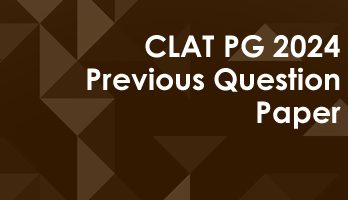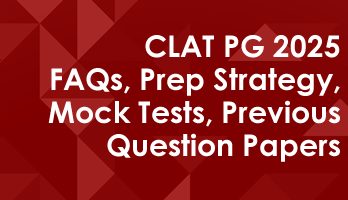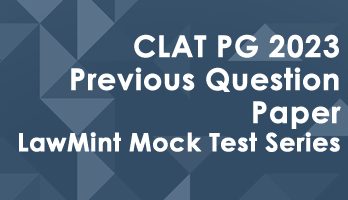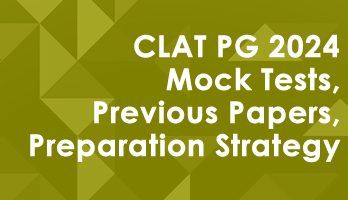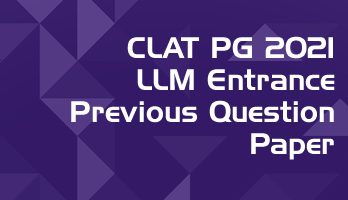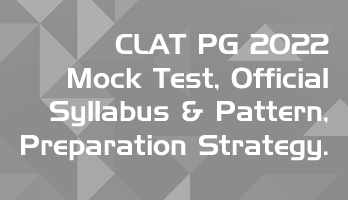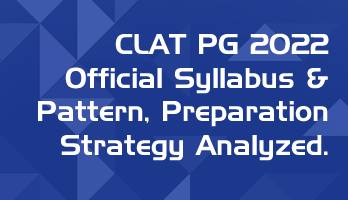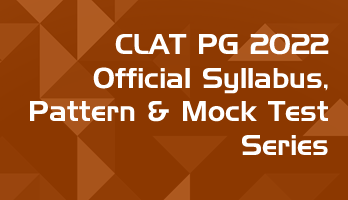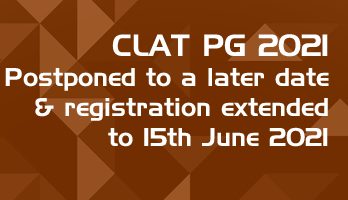This series of articles contains the complete CLAT PG 2020 question paper, conducted for the LLM admissions through the CLAT 2020 exam. In 2020, the pattern of the question paper was changed from the traditional MCQs to a ‘Comprehension based’ model. Each article in this series has one passage and the ten questions following it.
This article contains Passage 1 and the associated questions. The video embedded below discusses the answers as per the official key and the approach that can be used for such questions.
The answers to all the questions, for all the passages in the CLAT PG question paper are discussed in our YouTube video series at : https://www.youtube.com/lawmint
To make use of this question paper :
(1) The links to the complete series of articles is given below
(2) Read the passages and questions that follow
(3) Open our YouTube channel in another window or on your mobile phone (The video covering this specific passage is also embedded below.)
(4) Go through the series of videos where the answers to all the questions are discussed
The original plan by the CLAT Consortium was to have 10 passages, with 10 questions per passage and a subjective part. However, the subjective part was dropped and the number of passages was increased.
The CLAT PG 2020 exam had 12 passages, 120 questions – to be answered in 120 minutes. Click on the links below for the individual passages and the questions associated with the passage.
- Updated as per latest CLAT PG pattern
- Overall there are 300+ comprehension passages - with 2350+ questions
- 100 passages are provided as stand-alone mini mock tests
- 120 passages are combined to form 10 full-length mock tests
- 2020, 2021, 2022, 2023 and 2024 (New Pattern) Question papers included as mock tests
- Answers include the reason or 'rationale' for better understanding
- Order of the questions and answer choices are shuffled in every attempt for better practice
- The passages are of various lengths and complexities for better practice
- Unlimited access & practice - valid for one year from date of purchase
- Accessible 24 x 7 via Smart-Phone browsers and Desktops
- More the 100 LawMint users were selected by various top NLUs in 2020, 2021, 2022 and 2023 - Including NLSIU, NALSAR, NLU-J, WBNUJS
- Our users were also selected for the IIT KGP LLM, NLU Delhi (AILET PG) & DU LLM programs
Also included in the pack : (Useful for non-CLAT LLM entrance exams) :
- 11 CLAT PG old pattern previous Papers - 2009 to 2019 (as mock tests)
- 50 full-length old MCQ format mock tests (100 questions each)
- 50 old pattern MCQ mini-mock tests (25 questions each)
- Summarized overview of Important Jurisprudence topics (For Subjective & Objective questions)
- Overview of all Constitutional Amendments
- All Tests & Previous Papers are timed and have Negative marking for realistic simulation
- Questions & Answer Choices randomly shuffled in every attempt for better practice
Authentic Feedback from previous LawMint users :
I got AIR 21 in CLAT PG. Thank you so much. Your mocks helped me a lot in my preparation 🙂 - Ayushi Jain
I have subscribed to your CLAT PG program and got AIR 36 in this year CLAT PG. I have also secured AIR 54 in AILET PG exam. I would like to thank you. Your mock paper really helps a lot - Shrashank Tripathi
I would like to thank you for the CLAT PG LLM COURSE. Practising mock tests there helped me in getting confidence and hence I was able to get AIR 45 in CLAT PG LLM - Akshay Awasthi
A year back, I relied on the IIT Kharagpur RGSOIPL mock test series by LawMint to prepare for my RGSOIPL entrance test. Few months back, I relied on your UGC NET Law series to prepare for UGC NET. I was the topper of the RGSOIPL entrance, and have cracked JRF in UGC NET. All thanks to LawMint - Anshuman Sahoo
"I got AIR 18 in CLAT PG and General Category rank 28 in AILET PG. I want to thank you for helping me practice well in controlled conditions from any place. It gave me a lot of confidence and I took the tests while travelling too. I also made it to IIT Kharagpur." - Vinodharani
"Lawmint has been of great help to me in securing AIR 25 in AILET PG and AIR 29 in CLAT PG examinations. The subjective and objective approach of the test series kept me up to date with the latest exam pattern." - Bhawna Nanda
"I, Nimmy Saira Zachariah joined you clat test series. I cleared AILET PG with 30th rank. Your test series were of immense help as it gave me clear idea of where my preparations stand thank you once again law mint." - Nimmy S Z
"Hey guys. Where do I start? If I thought that getting AIR 59 in Clat PG was it, then how wrong I was. With Lawmint now I have cracked UGC NET as well." - Joyanta Chakraborty
- CLAT PG 2020 – Comprehension Passage 1
- CLAT PG 2020 – Comprehension Passage 2
- CLAT PG 2020 – Comprehension Passage 3
- CLAT PG 2020 – Comprehension Passage 4
- CLAT PG 2020 – Comprehension Passage 5
- CLAT PG 2020 – Comprehension Passage 6
- CLAT PG 2020 – Comprehension Passage 7
- CLAT PG 2020 – Comprehension Passage 8
- CLAT PG 2020 – Comprehension Passage 9
- CLAT PG 2020 – Comprehension Passage 10
- CLAT PG 2020 – Comprehension Passage 11
- CLAT PG 2020 – Comprehension Passage 12
CLAT PG Comprehension Passage 1
“9. We now come to the Division Bench judgment of this Court reported as Rajeev Kumar Gupta & Others v. Union of India & Others – (2016) 13 SCC 153. In this judgment, the posts in Prasar Bharati were classified into four Groups-A to D. The precise question that arose before the Court is set out in para 5 thereof in which it is stated that the statutory benefit of 3 per cent reservation in favour of those who are disabled is denied insofar as identified posts in Groups A and B are concerned, since these posts are to be filled through direct recruitment. After noticing the arguments based on the nine-Judge bench in Indra Sawhney vs. Union of India, 1992 Supp (3) SCC 217, this Court held:
14. We now examine the applicability of the prohibition on reservation in promotions as propounded by Indra Sawhney. Prior to Indra Sawhney, reservation in promotions were permitted under law as interpreted by this Court in Southern Railway v. Rangachari, AIR 1962 SC 36. Indra Sawhney specifically overruled Rangachari to the extent that reservations in promotions were held in Rangachari to be permitted under Article 16(4) of the Constitution. Indra Sawhney specifically addressed the question whether reservations could be permitted in matters of promotion under Article 16(4). The majority held that reservations in promotion are not permitted under our constitutional scheme.
15. The respondent argued that the answer to Question 7 in Indra Sawhney squarely covers the situation on hand and the reasons outlined by the majority opinion in Indra Sawhney at… must also apply to bar reservation in promotions to identified posts of Group A and Group B.
16. We do not agree with the respondent’s submission. Indra Sawhney ruling arose in the context of reservations in favour of backward classes of citizens falling within the sweep of Article 16(4).
21. The principle laid down in Indra Sawhney is applicable only when the State seeks to give preferential treatment in the matter of employment under the State to certain classes of citizens identified to be a backward class. Article 16(4) does not disable the State from providing differential treatment (reservations) to other classes of citizens under Article 16(1) if they otherwise deserve such treatment. However, for creating such preferential treatment under law, consistent with the mandate of Article 16(1), the State cannot choose any one of the factors such as caste, religion, etc. mentioned in Article 16(1) as the basis. The basis for providing reservation for PWD is physical disability and not any of the criteria forbidden under Article 16(1). Therefore, the rule of no reservation in promotions as laid down in Indra Sawhney has clearly and normatively no application to PWD.”
Source: Excerpt taken from a Judgment of three judge bench comprising of R.F. Nariman, Aniruddha Bose & V. Ramasubramaniyam., JJ.
1. The above passage has been taken from which of the following recent judgments, relating to the question of reservation in promotions for the disabled persons?
a) National Federation of the Blind v. Sanjay Kothari, Secy. Deptt. of Personnel and Training.
b) Siddaraju v. State of Karnataka & Ors.
c) Rajeev Kumar Gupta & Ors. v. Union of India & Ors.
d) Ashok Kumar v. Union of India & Ors.
2. Which of the following is true in context of the scheme provided under Article 16 of the Indian Constitution, relating to reservation in promotion?
a) Reservation in promotion can only be granted to the class of citizens mentioned under Article 16 (4).
b) Reservation in promotion cannot be granted to a class of citizen provided by the virtue of Article 16 (1).
c) The scheme of reservation in promotion can be extended to any class of citizens under the scheme of Article 16 (1).
d) Reservation in promotion defeats the scheme of Article 16 (1) and Article 15 (1).
3. The Union government has issued an office memorandum under which 3% reservation has been provided to the persons with disability, apart from the reservations provided to different class of citizens such as 27% for OBCs, 14% to SCs and & 7% to STs. Now, the total percentage of reservation has reached 51%, which is against the judgment given in Indira Sawhney v. Union of India. Now, choose the most appropriate option amongst the following.
a) The reservation provided to persons with disability is constitutionally valid as it falls within the horizontal scheme of reservation.
b) The judgment in Indira Sawhney is not applicable to the persons with disability and hence such reservation is valid.
c) The reservation provided to persons with disability is invalid as in no case reservation can increase 50%.
d) The reservation to PWD does not fall under the scheme of Article 16 (4) and hence unconstitutional.
4. What is the meaning of the “Catch-up” rule associated with the matters of seniority in reservation in promotion?
a) If the junior candidate promoted on the basis of reservation gets promoted to further grade by the time senior general category candidate is promoted to earlier grade, the question of seniority does not arise.
b) A reserved category candidate promoted on the basis of reservation earlier than his senior general category candidates in the feeder category, shall become junior when general category senior candidate too gets promoted.
c) The candidate promoted to higher grade on the basis of reservation remains senior even if his senior is promoted to the same grade.
d) None of the above.
5. The Article 16 (4A), provides for which of the following?
a) Catch-up rule.
b) Carry forward rule.
c) Consequential seniority.
d) All of the above.
6. The scheme of reservation in promotion is limited to which of the following as per the text of Article 16 (4A)?
a) Schedule Castes and Schedule Tribes.
b) Backward class of citizens.
c) PWD candidates.
d) All of the above.
7. Government policy of no reservation in promotion for class I and II posts was initially:
a) Struck down in C.A. Rajendra case.
b) Struck down in M. Nagraj case.
c) Upheld in Jarnail Singh case.
d) Upheld in C.A. Rajendra case.
8. Jarnail Singh case overruled the M. Nagraj on the issue of:
a) Collection of quantifiable data to determine inadequacy of representation of SCs and STs.
b) Collection of quantifiable data to determine the backwardness.
c) Collection of data on efficiency of administration.
d) All the above.
9. Creamy layer concept is applicable to
a) All reservations
b) SC ST reservations
c) OBC reservation
d) Only horizontal reservation
10. In Vivekanand Tiwari, Supreme Court held that the unit for reservation in universities should be:
a) University as a whole
b) Faculties of the University
c) Departments of the University
d) (a) and (b)
- Updated as per latest CLAT PG pattern
- Overall there are 300+ comprehension passages - with 2350+ questions
- 100 passages are provided as stand-alone mini mock tests
- 120 passages are combined to form 10 full-length mock tests
- 2020, 2021, 2022, 2023 and 2024 (New Pattern) Question papers included as mock tests
- Answers include the reason or 'rationale' for better understanding
- Order of the questions and answer choices are shuffled in every attempt for better practice
- The passages are of various lengths and complexities for better practice
- Unlimited access & practice - valid for one year from date of purchase
- Accessible 24 x 7 via Smart-Phone browsers and Desktops
- More the 100 LawMint users were selected by various top NLUs in 2020, 2021, 2022 and 2023 - Including NLSIU, NALSAR, NLU-J, WBNUJS
- Our users were also selected for the IIT KGP LLM, NLU Delhi (AILET PG) & DU LLM programs
Also included in the pack : (Useful for non-CLAT LLM entrance exams) :
- 11 CLAT PG old pattern previous Papers - 2009 to 2019 (as mock tests)
- 50 full-length old MCQ format mock tests (100 questions each)
- 50 old pattern MCQ mini-mock tests (25 questions each)
- Summarized overview of Important Jurisprudence topics (For Subjective & Objective questions)
- Overview of all Constitutional Amendments
- All Tests & Previous Papers are timed and have Negative marking for realistic simulation
- Questions & Answer Choices randomly shuffled in every attempt for better practice
Authentic Feedback from previous LawMint users :
I got AIR 21 in CLAT PG. Thank you so much. Your mocks helped me a lot in my preparation 🙂 - Ayushi Jain
I have subscribed to your CLAT PG program and got AIR 36 in this year CLAT PG. I have also secured AIR 54 in AILET PG exam. I would like to thank you. Your mock paper really helps a lot - Shrashank Tripathi
I would like to thank you for the CLAT PG LLM COURSE. Practising mock tests there helped me in getting confidence and hence I was able to get AIR 45 in CLAT PG LLM - Akshay Awasthi
A year back, I relied on the IIT Kharagpur RGSOIPL mock test series by LawMint to prepare for my RGSOIPL entrance test. Few months back, I relied on your UGC NET Law series to prepare for UGC NET. I was the topper of the RGSOIPL entrance, and have cracked JRF in UGC NET. All thanks to LawMint - Anshuman Sahoo
"I got AIR 18 in CLAT PG and General Category rank 28 in AILET PG. I want to thank you for helping me practice well in controlled conditions from any place. It gave me a lot of confidence and I took the tests while travelling too. I also made it to IIT Kharagpur." - Vinodharani
"Lawmint has been of great help to me in securing AIR 25 in AILET PG and AIR 29 in CLAT PG examinations. The subjective and objective approach of the test series kept me up to date with the latest exam pattern." - Bhawna Nanda
"I, Nimmy Saira Zachariah joined you clat test series. I cleared AILET PG with 30th rank. Your test series were of immense help as it gave me clear idea of where my preparations stand thank you once again law mint." - Nimmy S Z
"Hey guys. Where do I start? If I thought that getting AIR 59 in Clat PG was it, then how wrong I was. With Lawmint now I have cracked UGC NET as well." - Joyanta Chakraborty


